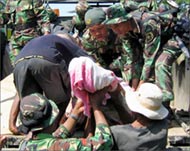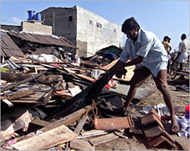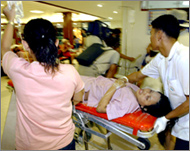Asian tsunami toll may exceed 50,000
At least 23,700 people are now believed to have died in Sunday’s tsunami in southern Asia according to the International Red Cross amid signs the final toll could top 50,000.

The tsunami, triggered by an earthquake in the Indian Ocean near the Indonesian island of Sumatra, was the biggest in 40 years registering 9.0 on the Richter scale.
It triggered 10-metre high waves that hit coastlines in Indonesia, Sri Lanka, India, Thailand, Malaysia and Myanmar.
With the toll mounting as communication with affected areas is restored, there are fears the final body count could more than double after Indian officials reported 30,000 people missing in the country’s eastern Andaman and Nicobar islands.
The toll on the island chain currently stands at 3000.
Five whole villages in the archipelago were swept away by a tsunami, district official GC Gupta said on Monday.
Several aftershocks, one measuring 6.0 on the Richter scale, hit the islands on Monday, but there were no reports of new damage.
Indian naval ships were steaming to the area which has a combined population of about 360,000.
In response to Sunday’s disaster, aid agencies have started to rush staff, equipment and money to stricken areas, warning that bodies rotting in the water were already beginning to threaten the water supply for survivors.
Rescue workers also spoke of bodies still caught up on trees after being flung inland by the waves.
Unbelievable
“I just could not believe what was happening before my eyes,” Boree Carlsson said from a hotel in the Thai resort of Phuket.
 |
|
Residents and soldiers evacuate |
“As I was standing there, a car actually floated into the lobby and overturned because the current was so strong,” said the 45-year-old Swede.
“I heard an eerie sound that I have never heard before. It was a high pitched sound followed by a deafening roar,” said a 55-year-old Indian fishermen called Chellappa. “I told everyone to run for their lives.”
In Indonesia, an archipelago of 17,000 islands, Aljazeera’s correspondent there, Sohaib Jassim, said nearly 5000 people had been killed and the toll was still expected to rise.
The worst affected area in the country was Banda Aceh, the capital of Aceh province, where 3000 people were killed. More than 200 prisoners escaped from a jail when the tsunami knocked down its walls.
The correspondent said some relief aid had arrived on Monday in the main street linking Medan and Banda Aceh, but added no vehicles could reach some badly affected coastal areas.
Sri Lanka devastation
In Sri Lanka, the toll shot up as the military and Tamil Tiger rebels reported nearly 11,000 people, including 70 foreigners, dead.
 |
|
Hundreds of thousands of homes |
One million people, or 5% of the population, have been affected.
Hundreds of thousands of Sri Lankans sheltered in schools and temples overnight, and officials expected the toll to rise further once rescuers resumed searches after daybreak.
India has so far counted more than 7100 fatalities, 3000 of which were in the Andaman and Nicobar Islands, and 3400 in the southern Indian state of Tamil Nadu, according to
police.
Beaches were littered with submerged cars and wrecked boats. Shanties on the coast were under water.
In Thailand, at least 839 people were killed and more than 7200 injured, including foreign tourists at seaside resorts in Phuket, the interior ministry said.
In Malaysia 51 people, including many elderly and children, were killed, officials said.
Preventable disaster
The head of the Pacific Tsunami Warning Centre in Los Angeles said US officials who detected the undersea quake tried frantically to get a warning out about the tsunami.
|
Tsunami Tsunami – Japanese for ‘harbour wave’ – is usually caused by earthquakes under or near the ocean. It is not a single wave, but a series of waves that can travel across the ocean at more than 800kph. As it enters the shallows of coastlines in its path, its velocity slows but its height increases. A tsunami that is just a few centimetres or metres high from trough to crest can rear up to heights of 50m as it hits the shore, striking with devastating force. |
But there was no official alert system in the region, said Charles McCreery, director of the National Oceanic and Atmospheric Administration’s centre in Honolulu.
“It took an hour and a half for the wave to get from the earthquake to Sri Lanka and an hour for it to get … to the west coast of Thailand and Malaysia,” he said.
“You can walk inland for 15 minutes to get to a safe area. We tried to do what we could,” he said. “We don’t have contacts in our address book for anybody in that part of the world.”
The earthquake struck at 7.59am (0059 GMT) on Sunday. It was the world’s biggest since 1964.
The resulting tsunami was so powerful it smashed boats and flooded areas along the east African coast, 6000km away.
In tourist paradise Maldives, where thousands of foreign visitors were holidaying, at least 43 people were killed and another 63 missing, officials said.
An international aid agency said at least 30 people were killed
in Myanmar and the toll was expected to rise substantially.
International aid
Aid agencies said with communications cut to remote areas in many of the countries, it was impossible to assess the full scale of the disaster.
 |
|
Hospitals are struggling to cope |
The Geneva-based International Federation of Red Cross and Red Crescent Societies said it was seeking 7.5 million Swiss francs ($6.5 million) for emergency aid funding.
The United States said it would offer “all appropriate assistance”, while the European Union pledged an initial three million euros ($4 million).
Experts said the top five areas to be addressed were water, sanitation, food, shelter and health.
“We’ve had reports already from the south of India of bodies rotting where they have fallen and that will immediately affect the water supply especially for the most impoverished people,” Christian Aid emergency officer Dominic Nutt said.